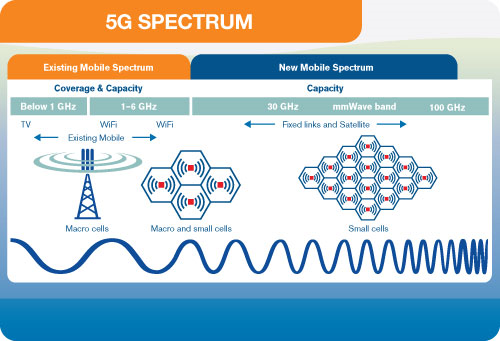5G AND ISPs
HIGH, LOW, AND IN BETWEEN
What is 5G, really? There is no simple answer to that question. 5G is much more than a new generation (read: another “G”) of cellular service. This new paradigm in telecommunications is far too expansive and complex to be fully addressed here. However, at the user end, the consumer end, there are some fairly simple dynamics to 5G.
For example, let’s examine how 5G will be delivered by the main telecom companies. And keep in mind that virtually all the tier 2 and 3 (ISP) providers will fall into these categories to one degree or another.
Essentially there are three spectrums available to deliver the faster, more efficient 5G service that telecom marketing people have told us to expect. The three are Low-band, Mid-band, and High-band. Each of those spectrums comes with cost and performance issues.
T-Mobile exemplifies the Low-band 5G system, particularly as T-Mobile stood prior to the acquisition of Sprint. The Low-band system requires minimal new infrastructure compared to other 5G services. Essentially T-Mobile is delivering a 5G experience using existing cellular coverage and the large towers that support 4G. 5G processors and chips are involved, but the 5G experience is reportedly less robust than other 5G delivery. The good news is that the T-Mobile system is better than many 4G or 4G LTE systems and the low band delivery is capable of “seeing around corners” and penetrating walls. It can be a boon to non-densely populated areas otherwise underserved when it comes to 5G…or, in some cases, “any G”. On the downside, the entirety of the promise of 5G may not be realized by Low-band delivery of service. It’s just slower.
Now comes Mid-band 5G. And, for this, let’s stick with T-Mobile. T-Mobile always knew the limitations of Low-band and the limited customer access because of it. So, they made a move to diversify. T-Mobile purchased Sprint (it was called a merger, but T-Mobile is already minimizing the brand “Sprint”). Why would they do this? Because Sprint had built a nice business around the Mid-Band 5G delivery system. The Mid-Band airways offer more speed than Low-band. They require a bit more infrastructure backbone, but they still penetrate buildings, and the combinations of infrastructure backbone make the service available to a broad array of customers in many kinds of locations. Many think this Mid-band space is a sweet spot for 5G delivery. For consumers, it is a potential upgrade over Low-band 5G.
Conversely, Verizon has gone the High-band route. High-band is millimeter wave and high frequency. That configuration probably delivers 5G as it was truly envisioned to average consumers…with a catch. The catch is that those consumers will benefit from living in population-dense areas. This is because the Verizon system rides on micro-cells (usually fed by fiber optic cable). These trash-can-sized small cells are deployed throughout cities and neighborhoods by the thousands. With hundreds of thousands more coming. The need for many small cells is fueled by the limits of that deployment system. The small cells need to “see each other” easily. This spectrum and these wave lengths cannot bend easily, nor can they penetrate solid objects like walls easily. Thus, they need to be densely deployed in large numbers. But, it is lightning fast. The ISPs are under pressure to make these small cells as attractive as possible so that their numbers do not become an ugly nuisance in cities. Many are made to fit somewhat camouflaged on streetlight poles for example. And some companies like Ericson are working to find ways to enhance High-band to better penetrate building walls. There will likely be hybrids of the small cell approach for industry at the enterprise level as they build their own dedicated inside plant networks linked to DAS/WiFi 6 systems. So, lightning-fast speed and low latency promise to be available in most big cities. These systems inside and outside will be connected to fiber optic backbone for maximum performance.
Low-band, Mid-band, and High-band are all considered necessary to deliver 5G to a country as diverse as The United States. And there is little doubt that these delivery mechanisms will continue to evolve…as technology always does.
At BbI, we are trying to constantly measure all the 5G delivery systems and find our place in the supporting infrastructure. This includes putting fiber in the ground in a wide range of ways. And it includes honing our capabilities of inside plant and distributed antenna systems (DAS) dovetailed into 5G and 5G/WiFi6 hybrid systems. It is a little complex, but we are up to the challenge. After all, we are called to enable the future; it’s who we are.
Broadband Infrastructure, Inc.


